London’s First Taxi Rank – The development of urban folklore?
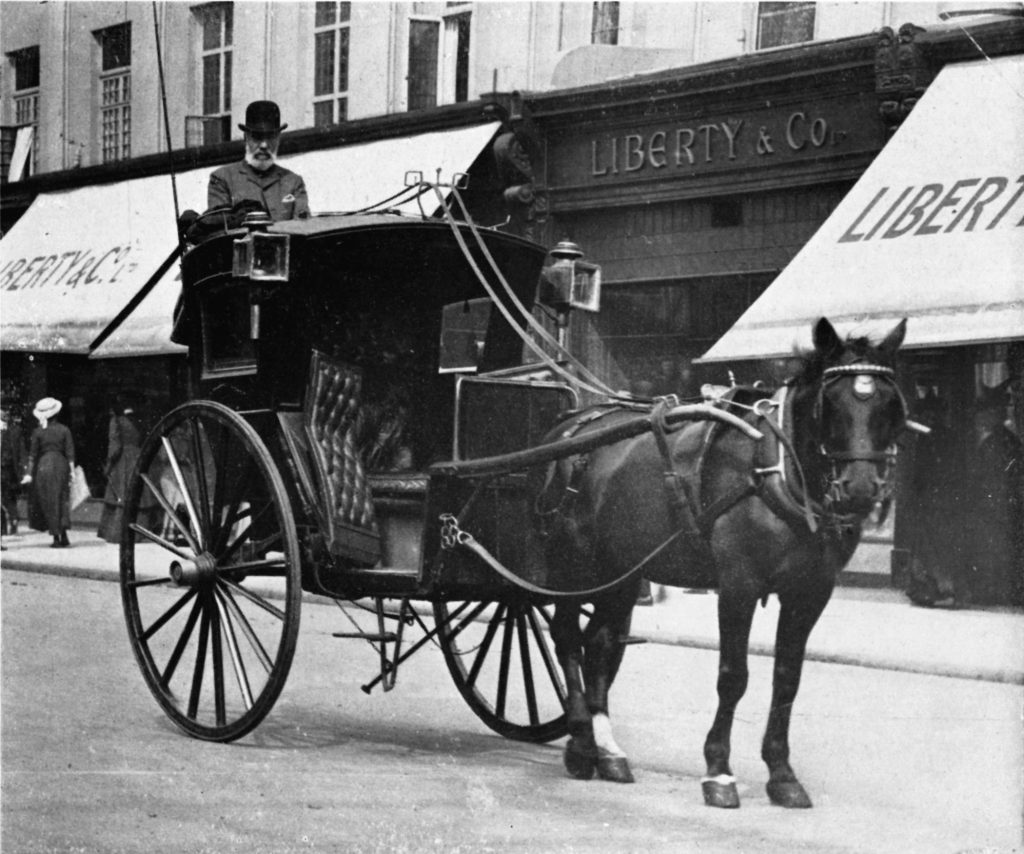
Introduction:
That title may seem either overly grandiose or simply just confusing, however, I promise there is good reason for the confusion. I began looking into this, seemingly simple, story of London’s first taxi rank around 4 weeks ago. One afternoon I was watching a video about the history of London taxis, the joys of missing your hometown from abroad, when I heard the presenter mention this story. Here is the basic outline:
At some point between 1625 and 1636 a certain Captain John Bail(e)y bought four hackney coaches and began operating them from the Maypole in the Strand. This would make the Maypole or May-pole the first taxi rank of London’s history. The Maypole, seen in the 1713 George Vertue’s engraving, was an incredibly tall flag placed on the current location of the St Mary on le Strand.
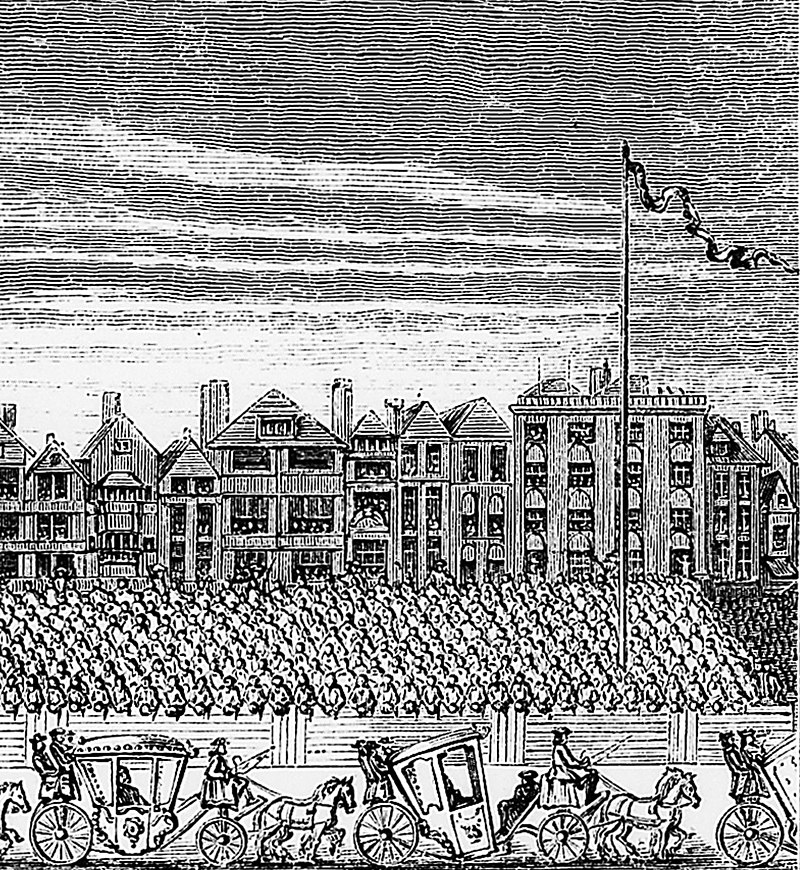
1713 engraving by George Vertue of a procession on the Strand where the Maypole is visible.
Why is it an urban legend?
At this point, you may be wondering why I have decided to call it folklore. The range of dates is a little wide, but the story seems plausible enough you may think. It makes sense that this incredibly tall monument, especially by the standards at the time, would be a gathering point for people, right? Well, here is where it becomes interesting.
Firstly, this Captain John Bail(e)y fellow could be a complete fiction. The details about the man are very fuzzy. It is said that he was a veteran of Sir Walter Raleigh’s campaigns. His name is spelt inconsistently over time which, admittedly, could be a reflection of poor record keeping. On the other hand, there is the issue of a lack of tangible sources. When you use a search engine to look into “London Taxi history” or “First taxi rank London” you will find dozens of references to hackney coaches, St Mary le Strand and Bail(e)y. Not one of them provide a primary source.
Secondly, the date is a problem. Some of the blogs claim it was 1625, others 1634, and even a subset claim a date as late as 1636. This, combined with the inconsistent spelling of Bailey’s name, begins to make this entire tale Robin Hood-esque. The character who may or may not have been present at a year unspecified to accomplish a hard-to-check feat. Urban folklore in contemporary London.
Examples of the folklore spreading:
It seems that this urban myth was perhaps told enough times as a passing statement that it may have become the truth. Let’s view examples of these blog posts:
- Nissan – The motoring company released a statement on the history of taxis in London to coincide with their release of a car model which will act as a black cab. They stated:
- “A more organised and structured taxi service was introduced in 1634 when Captain John Bailey – a regular member of Sir Walter Raleigh’s many expedition teams – set up London’s first taxi rank. He started with four Hackney Carriages by the Maypole in the Strand, and set strict rules for what drivers could charge.“
- DriveTribe – Motoring media company founded by ex-Top Gear presenters wrote a piece on the history of the London Cab.
- “In 1634, the first taxi rank had been established as Captain John Bailey, an owner of four hackney carriages brought them in front of the Maypole Inn. A tariff was charged for travel to various parts of London, drivers had to follow a strict set of rules and regulations, and carriages being painted in a distinctive livery for the sake of recognition from the surrounding area by potential customers. “
- Ingogo – An Australian taxi company, also wrote a piece on the history of taxis.
- ““
- The Knowledge of London, a London cultural blog.
- “By the year 1625, there were four-wheeled coaches plying for hire, with the very first Hackney cab stand to appear was at the May-pole in the Strand. Where Captain Baily is said to have accompanied Raleigh in his last expedition to Guiana, employed four hackney coaches, with drivers in liveries, to ply for hire, fixing his own rates.“
- London Vintage Taxi Association.
- “In 1634, a certain Captain Baily, a veteran of Sir Walter Raleigh’s expeditions, put four coaches to work by the Maypole in the Strand, dressed his coachmen in livery and told them what fares to charge. In doing so, he set up what was undoubtedly London’s first cab rank and established a business model that exists worldwide to this day.”
Not one of these articles provides a source of information explaining the origin of this story. These were five of many examples to choose from.
What do we actually know?
My point of writing this article is not to berate other blogs. Not at all! I almost fell into the same trap after watching that video. He mentioned this story of man starting the first taxi rank, and I thought, “It’s Strand history, and it’s about taxis: this is perfect for Strandlines!” Little did I know it would be one step forward and two steps back looking into this little bit of London history. I really struggled to find decent primary sources that made direct reference to both taxis or hackney coaches AND Bail(e)y. Even Raleigh’s book “The discovery of Guiana”, which is supposedly the campaign that Bail(e)y partook in, makes no mention to the Captain.
So, let’s start off far more basic. Can we find a primary source of the time that would help to clarify things? The answer is yes!
Samuel Pepys – A 1660 to 1669 diary
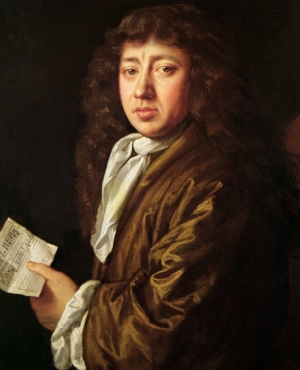
Portrait of Samuel Pepys – Famous diarist (1633-1703)
The Pepys diary was a blessing in more ways than one when it came to writing this article. Primarily, it helped to consolidate a key part of the story. By searching the entire digitized document for the term “hackney coach,” I found thirty-one references. Of these, one was of particular interest.
“I took coach for my wife and me homewards, and I light at the Maypole in the Strand, and sent my wife home.”
This confirms that there were certainly coaches for hire at the Maypole on the Strand in the 1660s. It is around 30 or 40 years off the mark, but, it quietens my doubts about the whole story being a myth.
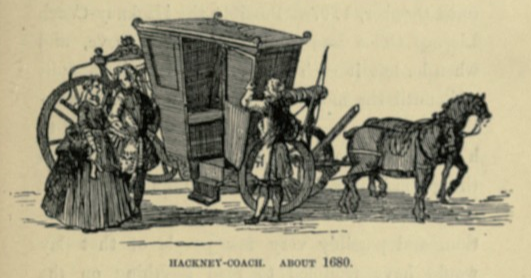
Hackney Coach Around 1680
As a bonus of beginning to search into Samuel Pepys, I was helped along the way by Strandlines Editor Tristan Tetteroo and a certain SJ Alexander. By reaching out on the community forum for the Pepys diary, Tristan discovered Alexander who in turn provided many useful sources.
Amongst these new sources, was “England under the Tudors and Stuarts” by Birchall (1861) confirmed the introduction of hackney coaches in 1625 with the following.
“In 1625, hackney coaches made their first appearance in London, and became so fashionable, that, ten years afterwards the government took alarm at their general use and endeavoured to diminish their number.”
Beyond Pepys – Looking for the man behind the story
Now that we have concluded that the taxi rank existed and the 1625 date does mark an uptick in hackney coach use, let us try to find out about Bailey. Observe the following evolution of this section of London history during the 19th century.
In Haydn’s (1841) “Dictionary of dates, and universal reference” states no reference to Bailey:
“Hackney coaches are of French origin […] The legend that traces their origin to Hackney, near London, is a vulgar error. They were first licensed in 1662.”
In Haydn’s (1866) “Haydn’s Dictionary of Dates Relating to All Ages and Nations: For Universal Reference” he has changed his views slightly:
On Hackney Coaches, “Four were set up in London by a capt. Bailey in 1625; their numbers soon increased. They were limited by the star-chamber in 1635; restricted to 200 in 1637 and in 1652 the number was raised to 400.”
There is mention in the Star Chamber records (January 19th, 1635) of this proclamation:
“The Kings Majesty took into consideration, the restraint of the multitude and promiscuous use of Coaches about London and Westminster. His Majesty perceiving that of late the great numbers of Hackney-Coaches were grown a great disturbance to the King, Queen and Nobility through the Streets of the said Citys”
Additionally, “It is worth observation, that in the first year of the Reign of King Charles, no Hackney-Coaches did stand in the Streets, but at their Stables.”
In Diprose’s (1876) “Some Account of the Parish of St Clement Danes” he explicitly mentions:
“In 1625 (the first year of Charles I), one Bailey, an old sea-captain, who had probably fought under Drake, Raleigh, or Essex, started four hackney coaches, which stood by St Clement’s Church.”
With these sources taken into consideration, it does seem likely that Captain John Bailey may have been the invention of 19th century British Historians. The sudden appearance of Bailey’s name in 1866 is somewhat confusing, and Diprose mentions him a decade later (most likely copying from Haydn) with a very confused report. Diprose mentions three separate military leaders Bailey may have served under. All in all, these sources lead anyone to believe that Mr Bailey is complete fiction.
Earl of Strafforde’s Letters and Dispatches (1634) – Bailey lives!
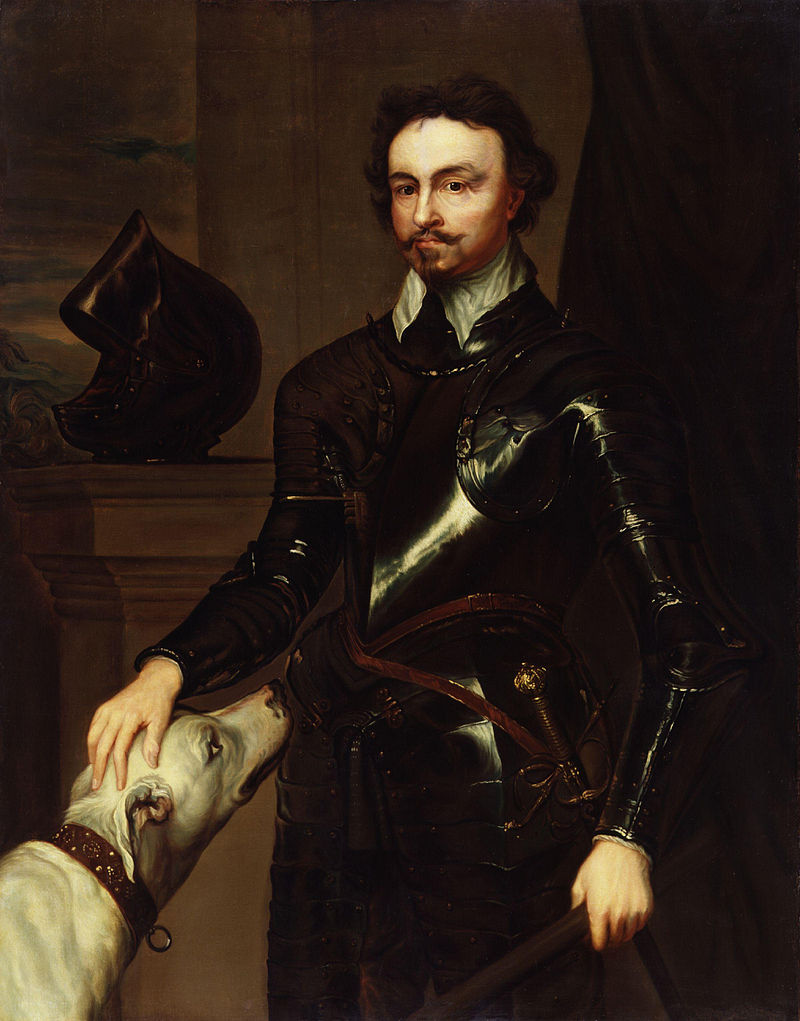
Thomas Wentworth 1st Earl of Strafforde (1593-1641)
At this point it may seem fairly clear cut. Taxis first operated from the maypole and John Bailey is just a good story which has been told enough times that it has become part of London’s mythology. Unfortunately, it could not be that simple. I present the last piece of evidence to consider, “The Earl of Strafforde’s Letters and Dispatches: With an Essay Towards His Life.”
“I cannot omit to mention any new Thing that comes up amongst us, tho’ never so trivial: Here is one Captain Baily, he hath been a Sea Captain, but now lives on the Land, about this City, where he tries Experiments. He hath erected according to his Ability some four Hackney Coaches, put his Men in a Livery, and appointed them to stand at the May-Pole in the Strand, giving them Instructions at what Rates to carry Men into several Parts of the Town”
This more or less confirms the existence of Bailey in a primary source text that lines up with the dates offered up by modern websites. In 1634, we can trace a certain John Bailey through a letter in the diaries of Thomas Earl of Strafforde setting up a Hackney Coach business at the May-Pole. London’s first taxi rank!
What is real? What is false? Does any of that matter?
The real:
- Taxis operated from the Maypole on the Strand, acting as London’s first taxi rank.
- John Bailey existed in one form or another, that much is pretty much certain as there would be no gain for the Earl to make up such a thing.
The fake:
- The dates fluctuate wildly depending on who is writing the story, even to this day.
- The spelling is also just a personal preference at this point (I like Bailey.)
- Diprose and Haydn… John Bailey may have existed, however, all mentions of the man seem to stem from the Earl of Strafforde’s letter. The additional details, such as where he had served, were clearly added later. This can be seen most clearly by Haydn and Diprose’s work. Haydn added Bailey after the fact and Diprose most likely used Haydn as a source around a decade later. Diprose saw Bailey had the title ‘captain’ and guessed three generals from around the right period and left it as that.
- Bailey may not have been the first to set up the Hackney Coach business at the Maypole. The dates indicate that as early as 1625 there were coaches, yet Bailey is only ‘in the picture’ through primary sources in 1634.
Does it matter?
Honestly? No.
Folklore is not about the facts behind the tale, it is about how it makes the reader feel. People do not read Robin Hood to get a historical piece on Sherwood forest! We read it to see a fight between good and evil, and to see justice be served. In the case of Captain John Bailey, we cannot use him as decisive proof of the first taxi rank in London. That being said, we can accept that the taxi rank existed and that it was there almost four-hundred years ago to this day! Bailey is the result of centuries of embellishment, and genuine urban oral history. In my own way, I only heard of this from word of mouth through a video on the internet. This is not in all the history textbooks. If it were, this article would have been much shorter! This is one of many examples of this ‘forgotten’ or, rather, ‘mythic’ history to explore in our city. I suspect I will be getting to grips with another winding investigation shortly.
My concluding thoughts:
It is a good story, and no-one can take that away from it. It took me a long time just to write this article after having all the facts laid out. This is a maze with either no exit or several. I’m not sure I have successfully made it out. Even if I did, I may have left through the wrong way. I don’t mind either way. This has been a great deal of fun, and good folklore should not have a clear-cut answer. The mystery is part of the intrigue.
References:
Birchall, J. England under the Tudors and Stuarts. Oxford University: Simpkin, Marshall & Company, 1861. https://books.google.ca/books?id=dY4BAAAAQAAJ.
Diprose, J., and J.B. Hopkins. Some Account of the Parish of Saint Clement Danes (Westminster) Past and Present. Some Account of the Parish of Saint Clement Danes (Westminster) Past and Present. Diprose and Bateman, 1876. https://books.google.ca/books?id=J81SAAAAYAAJ.
Haydn, J. Haydn’s Dictionary of Dates Relating to All Ages and Nations: For Universal Reference. 12th ed. The New York Public Library: E. Moxon and Company, 1866. https://books.google.ca/books?id=CEQQAAAAYAAJ.
Haydn, J.T. Dictionary of Dates, and Universal Reference. Oxford University, 1841. https://books.google.ca/books?id=eo3bC8OL_CIC.
Ibrahim, Jeremy Ethan. ‘The London Cab – The Most Iconic Form of Public Transport.’ DriveTribe, 2 December 2018. https://drivetribe.com/p/the-london-cab-the-most-iconic-CerOTdviRD2Gd4SYlX4qcg.
‘June 1654: An Ordinance for the Regulation of Hackney-Coachmen in London and the Places Adjacent. | British History Online’. Accessed 17 June 2021. https://www.british-history.ac.uk/no-series/acts-ordinances-interregnum/pp922-924.
LVTA. ‘London Taxi History’. London Vintage Taxi Association (blog). Accessed 17 June 2021. https://lvta.co.uk/menu/lvta-taxi-history/.
Nissan Europe. ‘THE LONDON TAXI: BACKGROUND AND HISTORY’. Official Europe Newsroom, 6 August 2012. https://europe.nissannews.com/en-GB/releases/the-london-taxi-background-and-history.
Pepys, Samuel (1633-1703). The Diary of Samuel Pepys. London: GEORGE BELL & SONS YORK ST. COVENT GARDEN CAMBRIDGE DEIGHTON BELL & CO, 1893. https://www.gutenberg.org/files/4200/4200-h/4200-h.htm.
Raleigh, Sir Walter. The Discovery of Guiana, 2006. https://www.gutenberg.org/files/2272/2272-h/2272-h.htm.
Rushworth, John. “Historical Collections: 1635,” in Historical Collections of Private Passages of State: Volume 2, 1629-38, (London: D Browne, 1721), 287-318. British History Online, accessed June 17, 2021, http://www.british-history.ac.uk/rushworth-papers/vol2/pp287-318.
Strafford, T.W.E., W. Knowler, and G. Radcliffe. The Earl of Strafforde’s Letters and Dispatches: With an Essay Towards His Life. The Earl of Strafforde’s Letters and Dispatches,: With an Essay Towards His Life. New York Public Library, 1739. https://books.google.ca/books?id=K2xZAAAAYAAJ.
The Knowledge of London. ‘The London Taxi | History of the London Taxi’. Accessed 17 June 2021. http://www.knowledgeoflondon.com/taxis.html.
Valdés Miyares, J. Rubén. ‘Who Was the Real Robin Hood?’ National Geographic, 6 February 2019. https://www.nationalgeographic.co.uk/history/2019/02/who-was-real-robin-hood.
Vrkic, Luke. ‘A Very Short History of the Taxi Cab’. Ingogo. Accessed 17 June 2021. https://www.ingogo.com.au/blog/a-very-short-history-of-the-taxi-cab.

Perhaps the Earl of Strafforde made up this Bailey character knowing it would lead someone down a rabbit hole nearly 400 years later. He could very well have been an early memer. Another interesting read!
Maybe it is like trying to prove if Jesus existed LOL, but millions around the globe agree he did!
The evidence there was a taxi rank is legit and you have to accept it started in England.
I can’t see why the Earl of Strafforde would make up a story that had visible evidence that the taxi rank existed! And it had to be attributed to someone, so why can’t we just accept Captain Baily seems the only obvious candidate? Why would the Earl use a meme? And don’t forget the writer of this website has already stated the Earl would not profit at all in celebrating this Bailey guy and his business.
I think it manly comes down to feeling embarressed to celebrate anything English and our many innovators in things like these!
[…] an otherwise inaccessible pre-Victorian Strand. There are horse-drawn carriages (reminiscent of the hackney coaches I discussed in another article), well-dressed people around town, children, and even dogs. This is the Bezer’s London when he […]